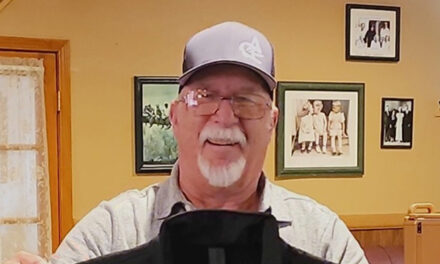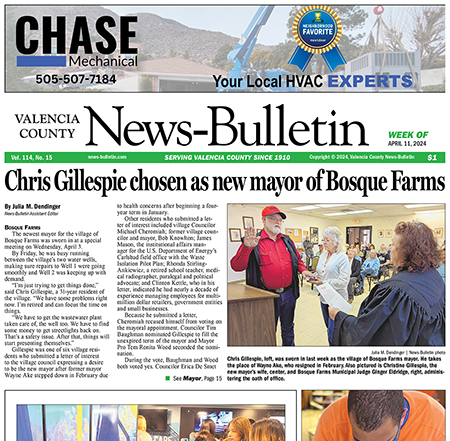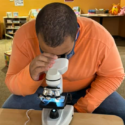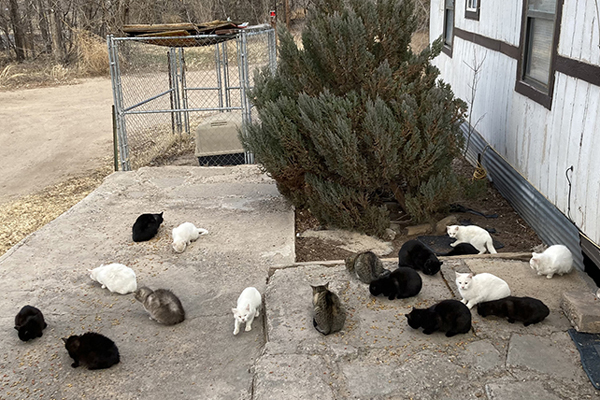
Felina Martinez | News-Bulletin photos
A feral cat colony gathers for food dispersed by a caretaker. It is estimated that about 28 cats make up the colony in Belen.
BELEN — Arriving at the Belen Rail Runner station, you may see a few shy, feral cats wandering about. What you may not see is this is just a scratch on the surface of what amounts to a large feral cat colony living right next door.
A Belen local, who cares for the colony, says they have been there for quite some time.
“Six or seven years, maybe longer, but that’s when I came into the picture,” said Dixie Pankotai. “It started with five to six cats. I can almost guarantee more have been dumped here.”
Since then, the colony population has increased to about 28 with the sheer amount of cats being most apparent at feeding time. They are skittish and slow to approach, but come a little closer to eat once they hear the sprinkle of food falling onto the pavement.
As they gathered to eat a couple of weeks ago, it was jarring to see more just keep on coming. Looking more closely at their rugged faces and bodies, one could tell some were ill as well.
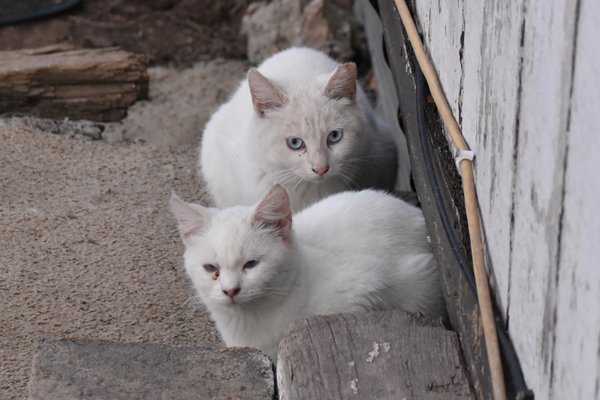
Sickly-looking feral cats are tested for diseases at the VCSNAP clinic when brought in, and get their combo FVRCP and rabies vaccine, said Shannon Kmatz, president of HART and director of VCSNAP.
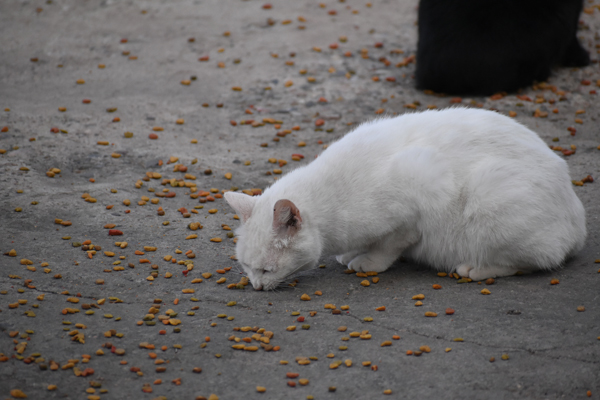
A feral cat is an unowned cat that is not socialized to people. Most ferals are fearful of people and keep their distance which is why they must be trapped to be spayed or neutered.
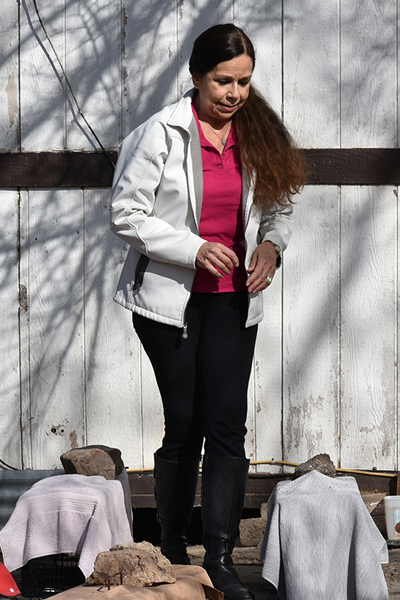
HART volunteer Deanna Sauceda gathers a group of trapped cats to take to VCSNAP. Sauceda and her husband spent multiple weekends trapping, transporting and returning the cats once they were spayed and neutered.
It was a solemn sight to see, which is why Homeless Animal Rescue Team (HART) volunteer, Deanna Sauceda, couldn’t help but step in.
“I happened to meet her delivering cat food, and that’s when I saw all the cats and asked if I could help, and she said, ‘yes,’” Sauceda said.
Prior to volunteering with HART, Sauceda volunteered with the Valencia County Animal Shelter delivering pet food and supplies to families in the county. She was also the executive director of the Spay Neuter Network in Dallas, Texas.
In late December 2022, Sauceda, of Peralta, contacted HART about the colony in Belen with the hope of implementing TNR (trap, neuter, return) to spay and neuter the cats and get them the medical care they needed.
“I don’t really like cats, and I’m allergic to cats, but they’re God’s creatures and I just know that it’s very unhealthy for them,” Sauceda said. “We want to work to keep the colonies healthy and eventually bring the numbers down so they’re not a nuisance to people in the area. (HART) said if I could trap them, they could get the surgeries done.”
And so began multiple weekends dedicated to setting traps, pick-up and transport to the VCSNAP spay and neuter clinic to get the colony under control.
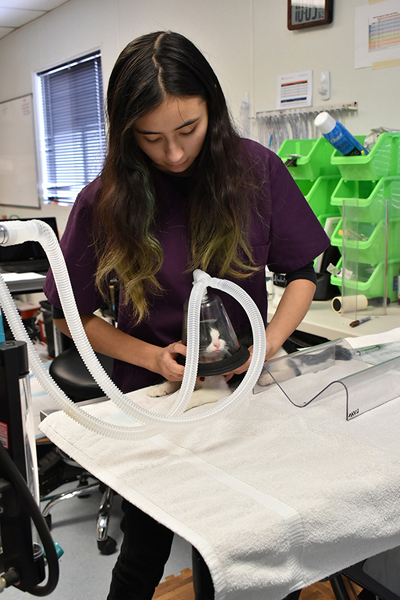
Lexi Abeyta, a vet tech at the VCSNAP clinic, prepares a cat for surgery by putting her under anesthesia.
Shannon Kmatz, president of HART and director of VCSNAP, said the TNR services are funded through grants and donations. The nonprofit organization has been doing TNR out of the clinic since October 2021. Since then, they have trapped, neutered and returned more than 900 feral cats.
“The best way of managing (feral cat colonies) is through spay and neuter. By fixing just one cat, we’re preventing many from being born and going through that cycle of having more kittens. It prevents the shelter from having to perform more euthanizations for space,” Kmatz said.
Apart from overpopulation, Kmatz says TNR prevents inbreeding and the spread of disease as all cats who undergo TNR are vaccinated and given medical attention if they need it.
“When a colony has a sickly-looking cat, we test them for other diseases that we may not vaccinate for and make decisions based on that. They all get their combo FVRCP and rabies vaccine,” Kmatz said. “They get treated for fleas and ticks if they have any. If they have an abscess or infections those will be treated as well.”
This was certainly important to the colony Sauceda worked with as there were several ill cats who had issues ranging from feline distemper to fleas.
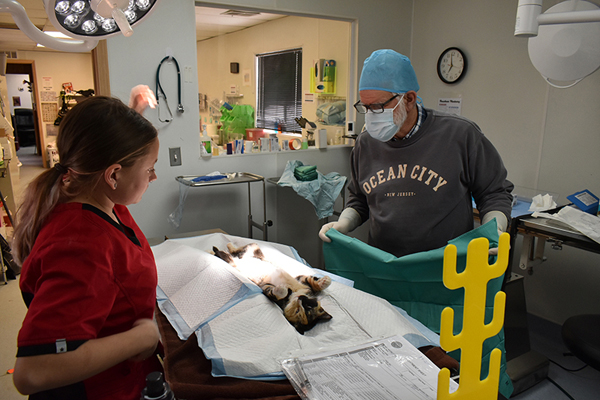
Veterinarian Ralph Zimmerman, right, and vet tech Shayla Marteney, left, prepare a cat to be spayed at the VCSNAP clinic. Volunteers help to ensure free TNR and low-cost spay and neuter options for Valencia County residents.
“They are able to get medical care they otherwise would have never had unless they went through the TNR process,” Sauceda said.
Once they are treated and spayed/neutered the cats are then ear-tipped, which “serves as a universal sign that a feral cat is fixed and vaccinated. It also lets animal control, code enforcement and the public know, Kmatz said.
The last step in the TNR process is return, which Kmatz says is what attracts backlash from some.
“Some people want them all euthanized, but we want to address the underlying problem. If you just go in and euthanize an entire colony, you’re not fixing the source,” Kmatz said.
“There’s a level of education that needs to happen with the process of TNR,” said Sauceda. “Some cities don’t engage with TNR and just have the cats trapped and euthanized, and then you’re most likely going to have a colony all over again.
“If you do TNR, over time it will reduce and eventually go away. But in the meantime, the cats are much happier and the colony is not increasing. They get medical treatment, they won’t multiply and you’ll be reducing their numbers in a humane way.
“It’s not an overnight fix,” Sauceda continued. “It takes time and it takes commitment, but it is the most humane and effective way to reduce your feral cat problem.”
Both Kmatz and Sauceda have seen significant, lasting impacts to areas that have undergone TNR.
“We map our colonies with a GIS map so we know where all the colonies are that we are fixing,” Kmatz said. “We’ve noticed in the colonies we’ve really worked that there are less animal control calls out there, less citizen complaints and less illnesses.”
As many know, this problem extends beyond the train station. All across the community, feral and stray animals, often the result of dumping and lack of spay and neutering, scrape by however they can.
“Spay and neuter is the most important thing when taking care of our dogs and cats,” Sauceda said. “People should understand the number of animals that are euthanized in our shelters every year. And the reason is because they are not spaying and neutering and not breeding responsibly. And as a result we get feral cats.”
Trying to tackle a problem as big as this can be daunting, but Sauceda emphasizes small steps in the right direction lead to lasting results and keep her motivated to continue.
“I just think of it as one person at a time, one animal at a time. And I guess that’s how I approach the cat colonies. It doesn’t have to be big, it can be one animal at a time” she said. “It can be through volunteering, making a donation, spreading the word about spay and neuter or helping a neighbor get their animal fixed.
“Each of us has to take a stake in it. To let it get worse and worse … I couldn’t do it. It’s not responsible.”
Top 5 reasons to spay or neuter animals
- Live longer: Intact pets have higher odds of getting certain cancers and urinary tract infections.
- No more roaming: Pets are less likely to go looking for a mate and be hit by a car.
- Happier pets: A fixed pet is not as stressed thus cutting down or eliminating behaviors such as marking, howling and aggression.
- Happier neighbors: Intact dogs that get loose are more likely to bite, spread disease, damage property and reproduce.
- Stops animal overpopulation: Shelters are full of adoptable dogs and cats who are euthanized for space which costs taxpayers millions.
(Source: spayneuternm.org)
Sauceda said the problem shouldn’t be dealt with by a few people alone. She said it will take the whole community working together to really turn things around as every one has a responsibility to our animals.
“That includes responsible spay and neuter, responsible care and making a commitment to that animal. When you get a puppy or kitten you are committing to a life,” she said. “You have a responsibility to that animal from day one to the day they die, and as a community it’s a statement about us when our animals are dumped, over-bred and left to over multiply. As a community, we need to step up,” Sauceda said.
To learn more about and to request HART’s TNR service, visit their website hartnm.com/tnr.
Spay and neuter resources:
In Valencia County
Spay-Neuter Coalition of New Mexico
Offers low-cost vouchers for spay and neuter, vaccines and microchips for dogs and cats in Valencia County. Visit their website, spayneuternm.org,to learn more and to sign up.
Homeless Animal Rescue Team
HARTNM provides free spay/neuter for feral cats in Valencia County, as well as a low-cost spay and neuter services for pets. Visit their website, hartnm.com,to learn more and to sign up.
Zimmer Feline Foundation
Provides free spay and neuter vouchers for lower income pet cats in New Mexico at participating veterinary clinics. Visit their website, zimmer-foundation.org, to learn more and apply.
Outside Valencia County
These are some programs currently offering low to no-cost spay and neuter programs or vouchers. Qualification requirements vary.
Felina Martinez was born and raised in Valencia County. She graduated from the University of New Mexico in 2021. During her time at UNM, she studied interdisciplinary film, digital media and journalism. She covers the village of Los Lunas, Los Lunas Schools, the School of Dreams Academy and the town of Peralta.

